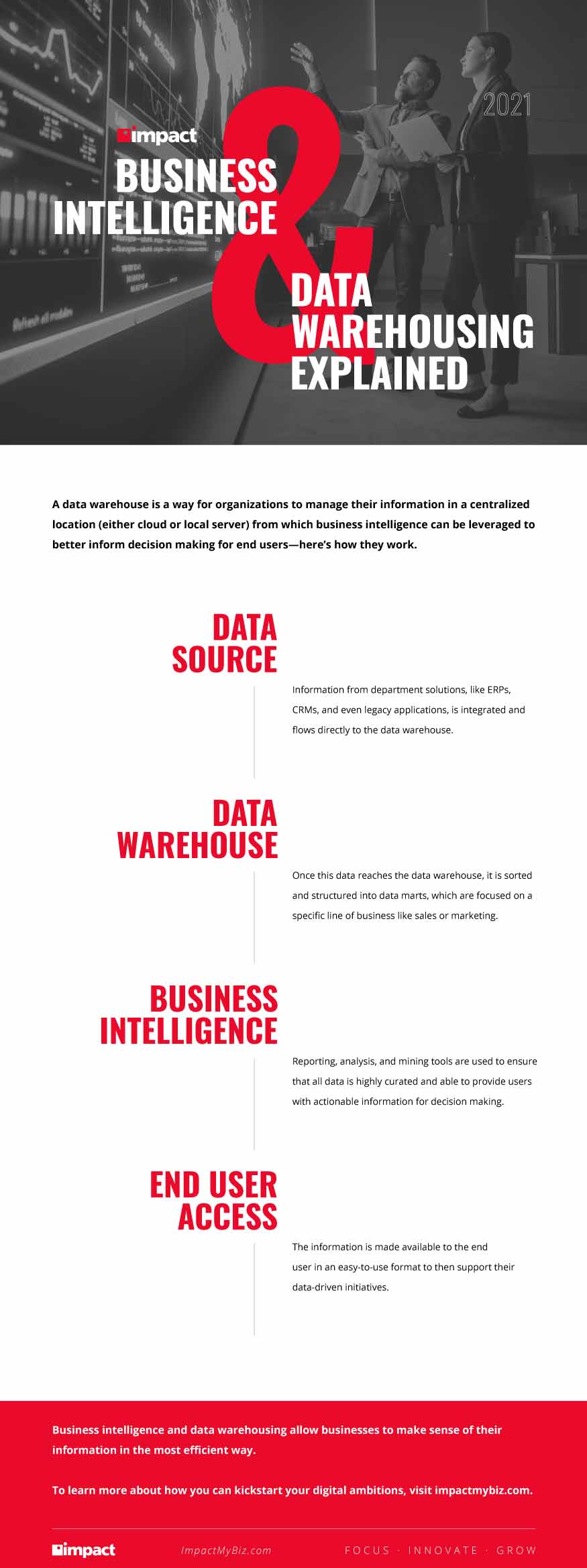Business intelligence and data warehousing are two aspects of digital transformation that are closely related when it comes to how information is stored, secured, and used.
Data warehousing is the process of transferring and storing data from multiple sources into a single repository known as a data warehouse. The data warehouse acts as a central data bank from which analytics can be performed through business intelligence tools.
Business intelligence, therefore, refers to the methods and tools used to access and analyze the data collected and stored in the data warehouse in order to provide business leaders with better data that informs their decisions.
For modern businesses, data warehousing and business intelligence are core components of a sound, data-based strategy that will provide deeper insights and will keep you on the cutting edge of your industry.
Take a look at this infographic for more detail on the relationship between data warehousing and business intelligence:
If you're ready to start making more informed decisions for your own organization, use Impact's checklist, What Businesses Need for a Successful Business Intelligence Strategy, to make sure your BI solution is implemented correctly and that you're getting the most out of it.
How Data Warehousing and Business Intelligence Come Together
Data warehousing and business intelligence, when optimized and used in concert, can function as the information backbone of an organization, helping them align every aspect of their business with a data-driven strategy.
Data silos occur when departments in a company collect, store, and analyze data independently from one another. While this is a fairly common problem that organizations face, it can lead to disparate decision making that’s only based on a portion of the data.
These data silos are especially common in organizations where some departments operate on legacy software that isn’t integrated with the rest of the company's IT infrastructure.
The cost of data silos is greater than one might think as organizations stand to lose out on nearly 30% of their potential revenue due to incorrect or siloed data.
To counteract this, the concept of a data warehouse was conceived, whereby data streams from all sources within a business would be directed to a central repository which can then be accessed easily by those working with the data on a regular basis.
Outline of How Data Warehousing and Business Intelligence Work
Data warehousing and business intelligence are truly two sides of the same coin and work together to bring organizations powerful insights with next generation analytics.
Here’s a little breakdown on how business intelligence and data warehousing fit together.
Data Source
Before you can jump into analyzing the data within your warehouse, you first have to source that data. This means you want to conduct an audit of the different departments in your organization and how they collect and store data currently.
From there you want to funnel your current reporting strategies into the data warehouse so that your analytics team can access the entire data library your organization keeps.
Much of this will be self-explanatory. For example, marketing reports from the customer relationship management (CRM) software or accounting reports from the enterprise resource planning (ERP) software. However, there are also some more difficult analytics that will be important to track, like customer telephone calls or email records.
Data Warehouse
Once the data that is needed has been identified, it’s time to extract and load it into the data warehouse.
This process is what’s referred to as “extract, transform, load” (ETL) and is a crucial component of loading data from multiple sources into one unified data repository.
ETL is very important because not only are you extracting the necessary information to the data warehouse, but you’re also using this step to cleanse the data to ensure quality and consistency across all databases—regardless of where or from which system the information originated.
The basic premise of ETL is that data is extracting to what’s called a “staging area”, which will comprise the data in raw form.
Unstructured data collectively accounts for 80-90% or more of all data and is continuing to grow.
Once the raw data is ready, it will undergo processing. Data processing means taking the raw data and ensuring that it is ready to be used for analytical purposes by end users. During this step, the data will be filtered, organized, and cleaned up for the end user. This means duplicate data, unusable data, and anything else that would hinder analysis is already accounted for.
Finally comes the load step, where the newly transformed data is sent from the staging area to its correct repository within the data warehouse.
Data loading is typically a fully-automated process that is done in batches on a continuous basis.
Business Intelligence
Once the data is in the data warehouse and has been processed correctly, it is ready to be analyzed by business intelligence (BI) tools.
Business intelligence tools and data analysts will then be able to further transform the information stored and processed in the data warehouse, producing deeper insights from the data which can then guide decisions.
Business intelligence tools translate large data pools held in data warehouses into digestible and actionable information.
Through automation, machine learning, and accelerated analytics, BI tools enable stronger data analysis, more accurate reporting, and enhanced operations through optimization.
While over half of all enterprises consider cloud BI to be either “critical” or “very important” to their ongoing and future initiatives, Exploding Topics reports that just 32% of business executives say they have the capacity to create measurable value from enterprise data and less than 20% of executives feel that they’ve established a “data culture” within their organizations.
End User Access
Once the business intelligence solution has used the data to generate the desired reports for end users, the system has to deliver this information to them in a way that is digestible and actionable.
The first three steps of this process as a whole are all focused on ensuring that the data is stored and prepared properly for use—these are backend processes.
The final step is a front-end process—the way the information is actually used by employees within the organization.
Most market-leading business intelligence tools, like Microsoft’s PowerBI, have great visualization functions so less technical users can begin applying the insights derived from data in their decision making without difficulty.
Producing data-driven insights that can guide decision making is an essential part of data warehousing and business intelligence.
The purpose of this entire process is to get valuable information into the hands of those that need it regardless of their data science background, so end user access should be a key consideration when shopping for the right BI solutions for your organization.
Wrapping Up on Data Warehousing and Business Intelligence
Data warehousing and business intelligence tools have become the standard for many business operations in a data-driven economy. This is partially because there is more data being collected and used by organizations than ever before, and those are the organizations at the cutting edge of their industries.
Exploding Topics reports Accenture’s finding that 67% of the global workforce have access to business intelligence tools.
This shows just how expansive business intelligence and data warehousing is on a global scale and demonstrates the value of investing in these solutions before falling behind the curve.
Begin your company's own business intelligence journey correctly using Impact's checklist, What Businesses Need for a Successful Business Intelligence Strategy.


